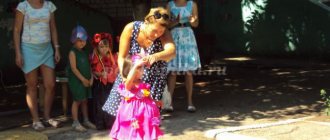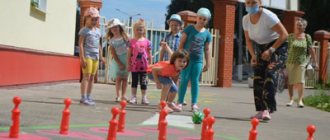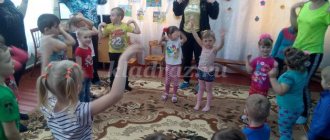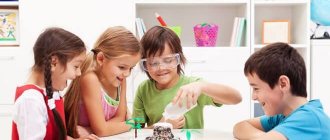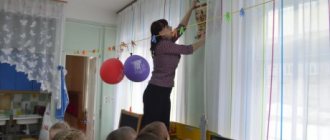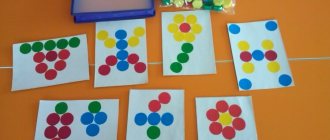Educational games in kindergarten are an integral part of the educational process. A kindergarten or preschool educational institution (preschool) is a type of educational institution whose main purpose is to implement a preschool education program. This is an affordable solution to the problem of parental employment. All preschool institutions provide care, education, development, supervision, and health improvement for children. A game is a special form of learning about the world, allowing a child to learn about the world around him in a simplified form and gain new experiences necessary for later life. What is the role of educational games in DOW? What is the difference between educational games in the younger group and the preparatory group?
Educational games in kindergarten: functions of games in the educational process
Attending kindergarten is an important stage in the life of any child. It is in the process of kindergarten education that the child gains his first experience of communicating with elders and peers, learns new models of behavior, and gets used to organizing the day. One of the main functions of any preschool institution is the education and development of the child. Every child learns about the world around him through games and toys.
A game is a form of activity and interaction between participants in the process, the main motive of which is to model a certain situation in a simplified form and test it in practice. Play for a child begins at an early age with learning about the world around him by studying surrounding objects and comparing them. The main elements of play for a child are both toys and objects from the surrounding world. The first year of a child’s life is characterized by the most intensive development and acquisition of basic skills, which will only improve in the future. With the acquisition of new skills and experience, the games that interest the child become more complex. Educational games in kindergarten contribute to the development of perception, logical, creative thinking, memory, attention, and imagination. Another important characteristic of educational games in dow is the socialization of the child, his involvement in team play, learning to evaluate and distribute roles.
Unlike the educational games that children enjoy at home, educational games in kindergarten are completely controlled by the teacher. Depending on the type of preschool institution, educational games in a preschool can be aimed at correcting certain conditions (physical development, mental development, speech therapy defects) and developing creativity.
Educational games in kindergarten are offered to children taking into account the age, level of development, abilities, and capabilities of the children. It should be noted that games in the younger group differ significantly from the games offered to children in older groups of kindergartens. What are these differences?
Games and toys for kids
Contained in sections:
- Didactic games 32382
- Sensory development and education. Sensory 6586
Includes sections:
- Didactic and sensory aprons and skirts 100
- Smell. Games, manuals “Recognize by smell” 9
- Velcro games 104
- Keyboard games 12
- Games with rubber bands 63
- Flashlight games 33
- Palms. Games, teaching aids 50
- Marbles. Games with pebbles 195
- Couple, pick a couple, couple pictures 282
- Pick up a patch. Games, teaching aids 66
- Clothespins. Games with clothespins for children 490
- Tactile development of children. Games and benefits 440
- Color, learning colors. Games, teaching aids 1513
- Laces. DIY games with laces 167
- Noise boxes. Games, educational aids 25
By groups:
- Junior group
Showing publications 1-10 of 1214. All sections | Sensory games
New
Photo
The best
Didactic game for sensory education “Snowman and Christmas tree”. Second junior group
Sensory development of children aged 3-4 years is an integral part of preschool education, aimed at increasing the level of intellectual development. Sensory and aesthetic development are closely related. A child who can easily understand sounds, colors and smells...
Abstract of the educational activity “Didactic games on sensory development with young children on the topic “Matryoshka toy” Abstract of the educational activity. Didactic games on sensory development with young children on the topic “Matryoshka toy”
Objectives: Teach children to compare objects by size (big - small, using appropriate adjectives in speech. Educational: - consolidate knowledge of basic...
Features of educational games in the younger group
Game is a unique mechanism that allows you to develop various qualities in a child. Thus, educational games in the younger group allow you to develop the child’s psyche, attention, fine motor skills, and logical thinking. Educational games for the youngest children have as their main goal the overall development of the child and his preparation for the next stage of development - preschool age.
In early preschool age, it is important to teach a child abstract thinking, logical analysis, planning and forecasting, and correct perception of the surrounding reality. Developmental games for preschool children are based on careful study and characterization of objects. Children are offered puzzles, mosaics, and various geometric shapes that develop the child’s spatial orientation. As a rule, in a preschool institution, games are played in groups, when children work together to solve assigned problems. Doing tasks in a group allows the child to learn how to work in a team, learn to coordinate their actions with the actions of other children, thereby learning the basics of relationships.
Educational games in kindergarten in the younger group are selected taking into account the developmental characteristics of children 3-5 years old. At this age, children are characterized by a certain independence and intolerance to adult help during games. The child strives to complete the task independently. As a rule, being under the care of parents, the child does not receive the same freedom of action as in kindergarten, where the child, being in a group of peers, cannot receive full attention from the teacher. The main task of the teacher is to monitor the child’s actions, analyze his abilities, acquired skills and abilities, as well as correct the educational process so that each child in the group receives comprehensive development.
Special attention in teaching and raising children in kindergartens is paid to physical development. Educational games in kindergarten are organized so that the child moves during the game and receives a certain physical activity. One of the exciting activities for children in the younger group is playing with suspended multi-colored paper butterflies, which will only be able to “fly” when the children blow on them with all their might. In this simple and uncomplicated game, the child develops coordination and lungs. The game can be modified and supplemented with the task of making the butterflies fly in a certain sequence: first red, then yellow, then blue.
Sensory games - The meaning of didactic games in sensory education of children
Publication “The Meanings of Didactic Games in Sensory Education...” The Meanings of Didactic Games in the Sensory Education of Children Galina Aleksandrovna Maltseva Teacher, MBDOU “General Developmental Kindergarten No. 68” Chita, Trans-Baikal Territory Abstract: the article discusses issues of interaction between the teacher and the family, as well as sensory development...
Image library "MAAM-pictures"
Card index of didactic games for the sensory development of young children. Card index of didactic games aimed at the sensory development of young children. Didactic games for learning colors: Game “Find the extra ball” Purpose: to consolidate knowledge of colors. Materials: plastic balls, 4 of each color (yellow, red, blue, yellow) Procedure: place on…
Characteristics of the didactic manual “Finger steps and sensory paths”
The first sensory rooms as a means of mental health improvement for children appeared in the 70s of the nineteenth century. in Holland and in the 80s - in Great Britain. There is also experience in using them in Russia, where in 2004 the first International seminar on the use of sensory rooms for…
Didactic manual “Sensory pyramid “Mom and baby” for early preschoolers
METHODICAL PURPOSE: A methodological guide as a didactic tool for children of early preschool age. OBJECTIVES: Educational To form ideas about the simplest perceptual actions (stroking, pressing, touching. To form the ability to correctly apply data...
Features of educational games in the preparatory group
Educational games for older preschoolers are also based on the characteristics of the age development of children. At this age, intensive physical development begins: nervous, endocrine, cardiovascular systems, musculoskeletal system. At the same time, the child’s psyche is reshaped, new psychological mechanisms and behavior are formed. At the age of 5-7 years, the formation of basic personal qualities occurs: personal motivation, new social needs arise (the need for recognition, approval, leadership).
The main task of educational games in the preparatory group is personal development, assistance in adaptation in the society of their peers, as well as preparing children for the next stage in development - school life.
To enter school, a child must have reading, writing, and counting skills. Developmental games in the preparatory group are aimed at developing these abilities. During this period, games take on a slightly different character: the gameplay increasingly imitates school activities.
During this period, children's knowledge and their analytical abilities are tested. Educational games in kindergarten allow you to consolidate acquired knowledge and skills about the main aspects of life and the world around us. Such skills and knowledge include the ability to distinguish good from bad by analyzing the proposed situation, distinguishing between domestic and wild animals, determining the seasons and relevant events, etc.
Games in kindergarten are an important stage in a child’s development, allowing them to understand the world around them in a simplified form and prepare for adulthood.
Card index of intellectual games in the senior group
MBDOU kindergarten No. 2 in Sychevka.
Card index of intellectual games
in the senior group
Conducted by: Birimzhanova.E V.
Game "Camera".
Target
: develop associative thinking, voluntary attention, memory, speech.
Game material and visual aids
: lotto cards or any other pictures.
Description
: Show the child the card for 5 seconds. Then remove it and ask them to remember what was depicted on it. If the child finds it difficult to answer, ask him a leading question: how much, what color, etc.
Game "Find the differences".
Target:
develop the ability to compare memorized objects, find similarities and differences in them.
Game material and visual aids:
story cards.
Description:
Show the child the card for 2-3 minutes. Then offer him a second card, on which some objects or actions are missing or replaced with others. The child must determine what has changed.
Game "Magpie-white-sided".
Target:
develop concentration and memory.
Game material and visual aids
: 5-6 small items (toys).
Description:
arrange objects (toys) on the table. Invite the child to look carefully at the table, remember what objects are on it, and then ask the child to turn away. Remove or replace one or more items. The child must determine what the magpie stole and what it replaced.
Game "Sleuths".
Target
: develop associative thinking, memory.
Description:
it is necessary to choose one child who will play the role of a “robber”, the rest - “detectives”. Tell some story with the children, from which it follows that the “robber” must now hide from the “detectives” and for this he needs to disguise himself. During the story, the “detectives” carefully examine the “robber,” who then goes off to disguise himself, and upon returning to the room they must find changes in his appearance.
Game "Describe the object."
Target
: teach to remember the signs and properties of an object.
Game material and visual aids
: objects familiar to the child (person, car, food, etc.).
Description:
Children, under the guidance of a teacher, choose a familiar object. The teacher suggests remembering as many distinctive features and properties of this object as possible and naming one feature at a time. The loser is the one who cannot remember anything about the item when it is his turn.
Game “Repeat the ornament”.
Target
: promote the development of concentration and memory.
Game material and visual aids
: beads, buttons, counting sticks (12 pieces each).
Description:
The teacher gives the child half of the playing material, takes the remaining half for himself, lays out an arbitrary composition of beads, then shows it to the child for 1-2 seconds. He must arrange exactly the same composition from his beads from memory. Then you can switch roles. To create the following compositions, you can add counting sticks and buttons to the beads.
Game “Remember - Draw”.
Goals:
teach conscious perception; develop concentration of attention on a memorized object.
Game material and visual aids
: a piece of paper, pencils, cardboard with images of objects.
Description
: stick six pictures on cardboard in two rows: three on top, three on bottom. The pictures should show the simplest objects: an apple, a scarf, a flag, a button, a needle, a Christmas tree, a birch leaf. Show your child the top row for one minute. The child must sketch what he saw and remembered. Then show the same bottom row of pictures and again ask the child to sketch everything that he remembers. Open all the pictures at the same time and compare how well the child’s drawings match the image.
Game “What is she like?”
Target:
promote the development of visual and auditory memory.
Description:
name an object and invite the child to imagine what this object looks like, what shape, color it is, what sounds it can make, etc. Then ask him to describe everything that he imagined. For example: an egg is oval, white or brown, with spots, raw or boiled, white and yellow inside. Then you can not only talk about the characteristics of the object, but also sketch it.
Game "Illogical Associations".
Target
: develop associative thinking.
Game material and visual aids:
cards with a picture of an object.
Description:
It is necessary to tell the child several words related to each other. For example: plate, soap, flower, street. It is better if the child has cards with images of these objects in front of him. Try with your child to find associations that would connect these words. Find a suitable picture for each association. Give space to the child’s imagination, do not limit them to logical associations. The result should be a short story.
Games for developing attention
Game "Who Lives Where".
Target:
develop visual attention and memory.
Game material and visual aids:
drawings with images of families of different animals and their houses, with drawn lines connecting the animals with their houses, which are given in a chaotic order.
Description:
you need to determine where whose house is without drawing a pencil along the lines.
Game "Clap Your Hands".
Goals
: develop stability and switching of attention, cognitive activity of the child; expand your horizons.
Description:
The teacher calls the child different words; if he hears a word that means, for example, an animal, he must clap his hands. Another time, suggest that the child stand up every time he hears a word for a plant. Then combine the first and second task, that is, the child claps his hands when he hears words denoting animals, and stands up when pronouncing words denoting plants. It's good to play these games with several children.
Game "Cross out all the letters K."
Target:
develop stability, distribution and switching of attention.
Game material and visual aids:
small text (from a newspaper or magazine), pen.
Description:
Invite the child to carefully look at the letters in the text and cross out all the letters “k”. Record the time and number of errors. The task can be made more difficult by asking the child to cross out all the letters “w” and underline all the letters “u”.
Game "Change appearance".
Target:
develop observation skills.
Description
: several people play, everyone stands in one line, the leader names one child and invites him to remember the appearance of each participant in the game. This will take 1-2 minutes. Then the child turns away, the remaining participants in the game make minor changes to their costumes or hairstyles. Turning to the players, the driver must name the changes that he was able to notice.
Game "True or False".
Target:
develop attention and memory.
Description
: the teacher pronounces different phrases - true and false. If the phrase is correct, the children clap, if not, then they stomp. For example:
In winter, daisies always bloom. (Children stomp.)
Ice is frozen water. (Children clap.)
Hares have red fur. (Children stomp.)
There is no need to wash your hands before eating. (Children stomp.)
It always snows in winter. (Children clap and stomp.)
Game "Little Beetle".
Target:
develop attention and spatial thinking.
Game material and visual aids
: playing field, lined with 16 cells; buttons.
Description
: the teacher invites the child to help the “beetle” (button) get to the other end of the field, while warning that the “beetle” crawls only in zigzags. The teacher marks a short segment of the “bug’s” path: “One cell forward, two to the right, one to the left.” The child must listen carefully, remember and follow this path with a “bug” across the playing field. When the child learns to remember all the moves of the beetle, you can move on to a more complex task by asking the child to make the moves mentally and place the beetle on the desired square.
Game “Follow the pattern”.
Target:
develop concentration.
Game material and visual aids:
checkered sheet with a pattern of squares, circles, triangles.
Description
: The child continues the sample pattern (circle, square, triangle, dot, etc.) on the sheet.
Thinking games
Game "Yes-no-ka".
Goals
: learn to ask questions, find criteria for classifying objects in the surrounding world; develop listening skills and being attentive.
Description
: the teacher thinks of a word or tells a story, and the children must guess the word or explain the situation by asking the same questions, to which one of the answers can be given: “yes” or “no.”
Game "Visual yes-no-ki".
Goals:
teach to analyze; develop thinking.
Game material and visual aids
: cards with images of objects (animals) or small toys.
Description:
lay out toys or pictures (no more than 10) on the table, give the child a little time to look at them. Then ask: “What object did I wish for?” The child, using leading questions (Is it on the right half of the table? Below? Is it yellow? Is it heavy? Is it round?) identifies the hidden object (picture). To begin with, it is better for the teacher to act as the questioner. This way the child will understand the game script faster.
Game "Treasure Chest".
Target
: develop imagination, analysis skills.
Game material and visual aids:
box (bag); any edible (inedible) thing that fits in a box (bag).
Description:
Invite your child to guess what's inside using ten questions.
Game "Who was who?"
Target:
develop attention and imagination.
Description:
the child must name the state that preceded what the teacher calls him.
For example:
- Who was the old man? (As a boy.)
-What was the tree? (Rostkom.)
-What was Pinocchio? (With logs.)
Game "Outside - Inside".
Target:
learn to relate the concepts of “big” - “small”, “inside” - “outside”.
Description:
name a couple of objects to the child and ask him to say what can be inside and what can be outside. For example: house - pillow, cutlet - pan, heart - cat, fish - river, sugar - tea, etc. Then switch roles - let the child name a couple of words.
Game "I - you".
Target
: develop logical thinking, speed of reaction.
Description:
the child must quickly understand what the opponent is talking about and answer him in the same way. For example, the teacher says: “I am a rainbow!” The child must answer: “I am the sun!” The teacher continues: “I am the sky.” The child answers: “I am an airplane.” Etc. (The game is suitable for individual lessons with a child and for playing in a small children's group.)
Game "Third Man".
Target:
learn to classify objects according to the criteria specified in the conditions.
Description
: the teacher names three words, for example: “dog”, “cat”, “fish”. The child must determine: all three words refer to the designations of wildlife, but “dog” and “cat” designate animals, but “fish” does not. This means that the word fish is “superfluous”. Examples of words: birch, pine, rose; soap, shampoo, toothbrush; milk, kefir, tea.
Game "Guess by description."
Goals:
develop speech (ability to coordinate adjectives and nouns); consolidate knowledge about concepts that unite certain objects or creatures.
Description
: Prepare riddle sentences in advance that children must answer.
For example:
• A beautiful insect with colorful wings, loves to fly, feeds on nectar. (Butterfly.)
• The transport is long, consists of several parts, runs on iron rails. (Train.)
• Wild animal, lives in the forest, howls at the moon. (Wolf.)
• A wild animal with red fur always deceives in fairy tales. (Fox.)
• Fruit with yellow skin. (Lemon.)
The game “What comes first, what comes next.”
Target:
learn to arrange pictures in order of plot development.
Game material and visual aids
: sets of pictures (for example, from N. Radlov’s book “Stories in Pictures”).
Description
: the teacher takes out the pictures and shows them to the children, then says that if you put them in order, you will get an interesting story, but in order to put them correctly, you need to guess what happened first, what happened next and how it all ended. After laying out the pictures, the teacher asks the children to peel back the cards glued to them on top. If the pictures are positioned correctly, then on top of the cards you can see a correctly diverging arrow. If the arrow turns out to be incorrect, it means that the pictures are located incorrectly, you need to correct the work. After completing the task, you can invite the children to retell the story they received.
Speech development games
Game "What is he like?"
Target
: learn to actively describe the characteristics of objects.
Description
: invite the child to bring everything square that he finds in the room. For example: a book, a box, a cube, etc. Ask him to describe all objects that are united by one characteristic - square. Let your child find and explain the similarities and differences of objects, as well as their purpose.
Game "What do you hear?"
Target:
develop hearing, the ability to recognize speech and non-speech sounds.
Game material and visual aids
: musical instruments (pipes, drum, rattles, tambourine), foil, paper, book.
Description
: the teacher sits the child on a chair with his back to himself: he should not see, only hear, and then determine what was played or what was used to produce the sound. It is advisable to start with something simple - with musical instruments, and then move on to something else: paper, foil, turning pages in a book. You can make the task more difficult by moving around the room and making a sound to the right or left of the child. Then switch roles. When answering, you can deliberately make a mistake and see if the child corrects the mistake. Ask him to repeat the sound.
The game "Who speaks how."
Target:
train phonetic memory (perceive, pronounce, distinguish sounds).
Description
: invite the child to show how a cow talks, how her baby talks, how their voices differ. The child not only learns to distinguish voices based on several characteristics, but also tries to analyze the difference between sounds.
Game "Pictures-riddles".
Target:
learn to distinguish between the main and the secondary; strengthen the skills of describing objects.
Game material and visual aids:
cards with images of various objects.
Description:
The driver is selected. He takes one of the cards out of the bag and begins to describe what is depicted on it. Players offer their answers. The next driver is the one who answered correctly first.
Game "Steps".
Target:
contribute to the expansion of vocabulary and speech development.
Description:
two teams line up opposite each other. A separate strip should be drawn between them.
The theme of the game is set. You can use the themes given in the previous game, and also name words, syllables, a specific letter or sound. You can take a step by saying the right word. The team that reaches the dividing line first wins.
Game "Prepositions".
Target:
strengthen preposition skills.
Game material and visual aids:
disposable cardboard plate, cube.
Description
: draw the plate into sectors. In each sector, write the prepositions “on”, “in”, “under”, “above”, “with”, “for”, “in front”, “to”, etc. The child throws the cube onto the plate. The sector in which the cube lands becomes playable. With the pretext of the gaming sector, the child must come up with a sentence. Keep it simple at first.
Game "Similar words".
Goals:
help to study synonyms, different meanings of the same word; learn to choose the most accurate words to describe a certain subject, avoid repetition.
Description:
Explain to the child that one and the same thing can be said in different words:
• Our kitten is cheerful. (Funny, funny, amusing, comical.)
• The weather outside today is sad. (Sad, joyless.)
• The hare is cowardly, what else can you call it? (Tearful, timid, fearful.)
• The hare runs away from the fox. How else can you say it? (He runs away, rushes, flees, flies at full speed, takes off his feet.)
Word game.
Target
: Expand words knowledge.
Description:
invite the child to name as many words as possible for toys, vegetables, trees, flowers, wild pets, birds, tools, furniture, professions.
Game "The meaning of the word."
Target
: learn to clearly express a thought, indicating the main type of use of an object, describing its characteristics.
Description
: invite the child to explain how he understands the meaning of the words “bicycle”, “knife”, “hat”, “ball”, “letter”, “umbrella”, “pillow”, “nail”, “donkey”, “fur”, “diamond”, “connect”, “shovel”, “sword”, “trouble”, “brave”, “hero”, “poem”, etc.
Literacy games
Playing with pictures in a book or magazine.
Goals
: consolidate knowledge of the alphabet; teach word formation; develop attention and concentration.
Game material and visual aids
: picture book (children's magazine), pencil.
Description:
Together with the child, choose any letter, say it several times, remember what words he knows for this letter. Then invite the child to find and circle this letter across the entire book page. After this, together with the child, count the number of letters found.
Game "Who Lives Here?"
Goals:
teach children to form words from the given letters; develop reading skill.
Description:
Together with your child, draw a house or a train with trailers, a rocket or a ship, an airplane on thick cardboard. Insert cards with letters into the window. The child must guess what words live in this house. Example:
• A, L, I, S, E, O - fox, forest, donkey.
• K, I, N, O, T, S, L - cat, whale, elephant, movie.
Game "Slogomyach".
Target
: develop the skill of dividing words into syllables, quick thinking.
Game material and visual aids
: ball.
Description:
one player names a syllable, and the other must add an ending to this syllable so that it becomes a word. For example, you can add “rowa” to the syllable “ko” - you get “cow”; you can add “sa” to “li” - you get “fox”. It is important that children follow the rule: divide words into syllables correctly and pronounce them as they are written: “ko-ro-va”, but not “ka-ro-va”.
Game "Book Detective".
Goals
: learn to correlate letters with specific pictures; develop quick thinking.
Game material and visual aids
: books with illustrations.
Description
: think of a letter and give the child a task - find a picture in the book for this letter. If several children are playing, introduce an element of competition: the one who finds the most required pictures wins. You can complicate the game by wishing for some object depicted in the book and warning the child that the intended word, for example, contains two letters “o”. (Cow.)
Game "Sleuths".
Goals:
consolidate knowledge of the alphabet; develop the ability to correlate abstract letters with the letters that make up a word.
Game material and visual aids
: cards with letters.
Description:
Place cards with letters on different objects. The child must find all the cards and check whether they are laid out correctly, that is, whether the letter on the card corresponds to the letter with which the name of this item begins. For example, a card with the letter “k” lies on the sofa - this is wrong, it should hang, for example, on a picture. You can complicate the game by replacing cards with letters with cards with syllables.
Game "Following".
Target
: develop reading skills (introduce the arrangement of words in the text, teach reading with intonation).
Description
: The teacher and the child, sitting at the table, read a book. The teacher reads, and the child lags behind a little, repeating everything that the teacher reads. The child not only hears the text, but also sees it. It doesn’t matter that he doesn’t really read, he sees what words and sentences are made of, what punctuation marks accompany the text. He remembers the spelling of words, can recognize the simplest ones, and learns to respond to punctuation marks. The child ceases to be afraid of long words and sentences and tries to pronounce them correctly.
Game "Illustrator".
Goals:
learn how to handle a book; instill a love for books; develop narrative speech, imagination, logic.
Description
: Read a poem or short story to your child. Then offer to complete the task - match the pictures to the read text from other books. After this, ask him to retell the plot (short plot) of the work, based on the drawings he has selected.
Games for mathematical development
Game "Correct Score".
Goals:
help in mastering the order of numbers in the natural series; strengthen forward and backward counting skills.
Game material and visual aids:
ball.
Description:
children stand in a circle. Before starting, they agree in what order (direct or reverse) they will count. Then they throw the ball and call the number. The one who caught the ball continues the count by throwing the ball to the next player.
Game "Who's Where".
Target
: learn to distinguish the position of objects in space (in front, behind, between, in the middle, on the right, on the left, below, above).
Game material and visual aids
: toys.
Description:
place toys in different places in the room. Ask the child which toy is in front, behind, next to, far, etc. Ask what is on top, what is below, on the right, on the left, etc.
Game "A lot and a little."
Target:
help to understand the concepts of “many”, “few”, “one”, “several”, “more”, “less”, “equally”.
Description
: ask the child to name single objects or objects that are many (few). For example: there are many chairs, one table, many books, few animals. Place cards of different colors in front of the child. Let there be 9 green cards and 5 red cards. Ask which cards are more and which are fewer. Add 4 more red cards. What can we say now?
Game "Guess the number."
Goals:
help prepare children for basic mathematical operations of addition and subtraction; help consolidate the skills of determining the previous and subsequent numbers within the first ten.
Description
: ask, for example, which number is greater than three but less than five; what number is less than three but greater than one, etc. Think of, for example, a number within ten and ask the child to guess it. The child names different numbers, and the teacher says whether the number named is greater or less than the intended one. Then you can switch roles with your child.
Game "Counting Mosaic".
Goals:
introduce numbers; learn to match quantities with numbers.
Game material and visual aids:
counting sticks.
Description
: Together with your child, make up numbers or letters using counting sticks. Invite the child to place the corresponding number of counting sticks next to the given number.
Game "Dot Traveler".
Goals
: introduce the basics of writing numbers; develop fine motor skills.
Game material and visual aids
: checkered notebook, pen.
Description:
The teacher sits down at the table, puts the notebook down correctly, and shows the child how to hold a pen correctly. Offers to play dot-traveler. To do this, you need to invite the child to put a dot in the upper right corner of the cell, then in the fourth cell of the left corner at the bottom of the notebook, etc.
Game "Reading and counting".
Goals:
help to understand the concepts of “many”, “little”, “one”, several”, “more”, “less”, “equally”, “as much”, “as much”; develop the ability to compare objects by size.
Game material and visual aids
: counting sticks.
Description:
When reading a book to a child, ask him to put aside as many counting sticks as, for example, there were animals in the fairy tale. After counting how many animals there are in the fairy tale, ask who there were more, who were fewer, and who were the same. Compare toys by size: who is bigger - a bunny or a bear? Who is smaller? Who is the same height?
Games for studying the plant world
Game "How do trees live?"
Goals:
develop speech; help in studying the plant world.
Game material and visual aids
: cards with images of trees in different seasons (summer - a green tree, autumn - a tree with yellow leaves, winter - a tree without leaves, spring - a tree with swollen buds).
Description:
find out what time of year it is now. What the trees look like, what kind of leaves they have. Ask your child if he knows what happens to trees in autumn, spring, winter? Look at the pictures. Tell your child that the change of seasons affects the state of plants (in winter all plants fall asleep, in spring they awaken, in autumn they prepare for sleep, etc.).
Game “Where is whose leaf?”
Goals
: develop the ability to classify objects by characteristics, memory, attention; help in studying the plant world.
Game material and visual aids
: cards with images of trees (oak, maple), leaves of these trees, cut out of paper or real.
Description
: Mix the leaves. Tell your child a fairy tale about how an evil wind tore all the leaves from the trees and mixed them up. They feel cold lying on the ground and want to go back to their trees.
We need to help the leaves find their mother (father) - the tree. Invite your child to put the leaves near the corresponding tree. In the first lessons, choose leaves of a memorable shape (maple, oak, rowan). As you study trees, increase the number of varieties of leaves and trees. Select leaves of different trees that are similar in shape, carefully examine them, finding differences.
Game "Orchard".
Goals
: develop speech, classification skills; introduce you to the plant world.
Game material and visual aids:
dummies of fruits and vegetables; cards with images of fruit trees.
Description
: Place fruits and vegetables in front of the child. Explain that the doll wanted to make compote, but the fruits were mixed with vegetables, and she couldn’t choose them because she didn’t know how they differed from each other. After the weight differences are identified, invite the child to separate fruits from vegetables. Ask if the child knows where fruits grow. Look at the fruit trees shown in the pictures. Cut an apple or orange and show your child the seeds hidden in them. To summarize: Fruits grow on trees. Trees are called fruit trees. Specially planted, such trees form an orchard. You can talk about what is prepared from fruits and what dishes they are added to.
Game "Indoor Flowers".
Goals:
develop the skill of independence; introduce you to the plant world.
Description
: if there are indoor plants, invite your child to take care of them. Give him a watering can, teach him how to loosen the soil, and wipe the leaves of plants with a damp sponge. Tell us that the plants have come a long way before reaching the windowsill. After all, many of them came to us from distant countries - India, Mexico, Africa, etc. If the child expresses a desire, find these countries on the world map. Continuing the story, explain that the weather conditions of those countries are different from ours,
therefore, each flower requires special care: sun or shade, a lot or little water, heat or coolness. When offering to water this or that plant, note: “To water this flower, you need to put very little water in the watering can, but this one likes to drink a lot, so please try to get a lot of water.” Explain to the child why the holes are made in the pots, why the soil needs to be loosened, why the dust should be wiped off the leaves, etc.
READING AND WRITING
Your child will need these skills in school. After all, the first thing he will have to master by first grade is reading and writing.
In the fifth year, you need to plan lessons with your preschooler to prepare your hand for writing. Here you will already need the first teaching aids - children's copybooks. These are excellent “developers” for the hand, helping the child develop the necessary muscles so that the hand does not get tired while writing. In children's copybooks, the child is asked to trace simple patterns point by point and then reproduce them independently.
To reinforce the perception of the first sound in a word (the entire study of letters is based on this), you can glue cards with images of letters to different objects in the house. Let the child determine in which case the card is glued correctly and in which case it is not.
When teaching preschoolers to read, more and more mothers choose Zhukova’s primer. It consistently shows how letters “merge” into syllables and gives important recommendations to parents. In addition, Zhukova’s teaching methods meet the requirements of school curricula.
Advice
Before you start teaching your child to read, teach him to hear all the sounds in words, in different parts of the word (at the beginning, middle, end), and also to isolate syllables in words. You can find many entertaining games for this.
Only with this approach will the child learn to read and write without errors (children often transfer into writing what they hear or perceive incorrectly).
MEMORY IS NOT ONLY VISUAL
A person remembers not only what he sees, but also what he hears or does. Little Man is no exception. Therefore, memory development must be comprehensive and affect all these aspects.
- Visual memory is developed by games for memorizing a drawing or picture with their subsequent description, describing from memory the location of objects in a room, on a shelf, on a table. You can ask the child to remember what he wore for a walk yesterday, what his mother was wearing. Or draw a grid of several cells on paper, place small objects in each, and then, after giving the child time to memorize, turn it away and swap several objects. Let him try to restore the original arrangement.
- Auditory memory is trained by memorizing poems, nursery rhymes, songs, as well as retelling fairy tales or impressions of significant events, and following oral instructions from an adult. For example, buy several items in an impromptu store and not forget anything. Or place items, setting the table, in a certain sequence.
- Motor memory can be trained by all kinds of games in which children repeat the movements of adults in a certain order. Sometimes an adult can “make a mistake,” while the child needs to do everything correctly and not get lost.
Advice
When going to the store or for a walk, plan your route in advance and ask your child to comment on where to go next. This is also auditory memory training.
ATTENTION – ATTENTION
In order for a child to grow up attentive, be able to concentrate and quickly respond to any changes, it is important to train his attention. You can start as early as 4 years of age. At the same time, it is also not necessary to purchase expensive manuals: the suitable “equipment” is always at hand.
For example, you can play these games.
- Variations on the theme “edible - inedible” (sweet - unsweetened, flies - does not fly, clothes - not clothes).
- "What's new?" (on the table, in the picture, in the guise of dad, in mom’s clothes).
- “Find the differences” (in two pictures).
- “Caravan” - the mother names the animal, the child repeats it and adds his own. Mom repeats both and adds a third. You need to repeat in the order in which the animals are named. They play until someone gets lost.
- "What changed?". During a morning walk, mother and child try to remember everything that surrounds them, and in the evening they compare what has changed (someone hung up the laundry, old women sat on a bench, a car drove up to the next door);
- Close your eyes and name as many different sounds as possible in the room (a clock, the noise of a refrigerator, the purring of a cat) or outside the window (cars driving, birds singing, the wind rustling).
- Close your eyes and tell what order is on the shelf, on the table, what mom is wearing.
It is important to start with easier tasks, gradually making them more difficult, and not forgetting to praise your child for success.
